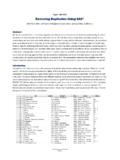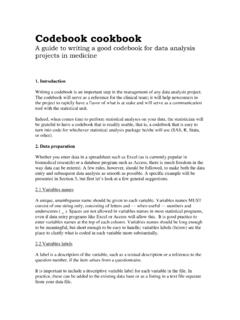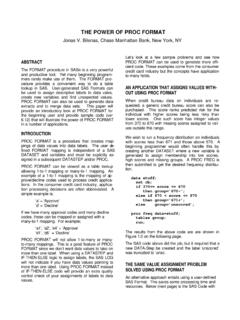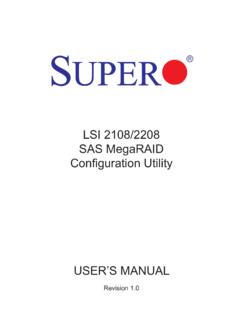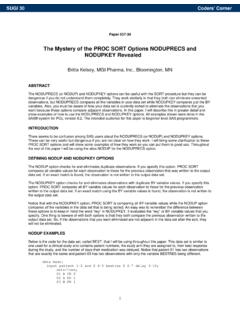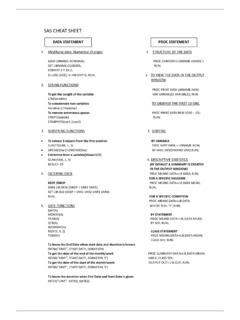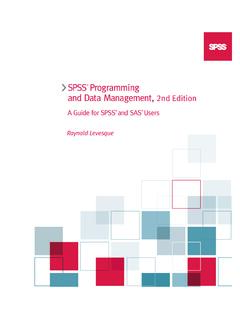Transcription of Laboratory Procedure Manual - Centers for Disease Control ...
1 Laboratory Procedure Manual Analyte: Glycohemoglobin Matrix: Whole Blood Method Tosoh A1c Plus Glycohemoglobin Analyzer as performed by: Fairview-University Medical Center University Campus Collaborative Studies Clinical Laboratory Minneapolis, Minnesota Contact: Dr. Michael Steffes Glycohemoglobin in Whole Blood using Tosoh Plus NHANES 2007-2008. Public Release Data Set Information This document details the Lab Protocol for testing the items listed in the following table: File Variable Name SAS Label Name GHB_E LBXGH Glycohemoglobin (%). There was an upgrade in instruments in June 2007. During the first six months of 2007. the Laboratory used Tosoh Plus and from the second six months forward the Tosoh G7. Automated HPLC System Glycohemoglobin Analyzer was used. The method used in the first half of 2007 is described in a separate document 2. Glycohemoglobin in Whole Blood using Tosoh Plus NHANES 2007-2008.
2 1. SUMMARY OF TEST PRINCIPLE AND CLINICAL RELEVANCE. Hemoglobin subfractions formed by the glycation of the alpha or beta chains of hemoglobin A1 (HbA) are collectively known as glycosylated or glycated hemoglobins. Hemoglobin A1c, the best-defined of these, is formed by the reversible condensation of the carbonyl group of glucose and the amino group at the N-terminus of the beta chain of hemoglobin A, resulting in a labile aldimine or Schiff base. As the red cell circulates, some of the aldimine undergoes a slow, irreversible conversion (Amadori rearrangement). to a stable ketoamine form (HbA1c). As blood glucose levels rise, the increase in glycated hemoglobin is proportional to both the level of glucose and the lifespan of the red cell. Hemoglobin A1c measurements are used in the clinical management of diabetes to assess the long-term efficacy of diabetic Control . The glycated hemoglobin result is a reflection of the mean daily blood glucose concentration and the degree of carbohydrate imbalance over the preceding two to three months.
3 In the past, accurate measurement of stable HbA1c was possible only after removing labile HbA1c by pretreatment. In this assay, the stable (SA1c) and labile (LA1c) forms can be individually resolved on the chromatogram without Manual pretreatment, allowing accurate measurement of the stable form of HbA1c. The analyzer dilutes the whole blood specimen with Hemolysis & Wash Solution, and then injects a small volume of the treated specimen onto the HPLC analytical column. Separation is achieved by utilizing differences in ionic interactions between the cation exchange group on the column resin surface and the hemoglobin components. The hemoglobin fractions (A1c, A1b, F, LA1c, SA1c, A0 and H-Var) are subsequently removed from the column material by step-wise elution using Elution Buffers 1, 2 and 3, each with a differing salt concentration. The separated hemoglobin components pass through the photometer flow cell where the analyzer measures changes in absorbance at 415 nm.
4 The analyzer integrates and reduces the raw data, and then calculates the relative percentages of each hemoglobin fraction. Analysis requires three minutes. 2. SAFETY PRECAUTIONS. Follow all procedures and policies in the Fairview-University Medical Center Laboratory Safety Manual . Consider all specimens as potentially infectious. Sodium azide can react with copper and lead plumbing to form explosive metal azides. On disposal, flush reagents with a large volume of water to prevent the buildup of azides. 3. COMPUTERIZATION; DATA SYSTEM MANAGEMENT. NHANES SA1c% results are entered unto a spreadsheet provided electronically by WESTAT, Inc for NHANES. To access the spreadsheet click on My Computer Z drive User Dep Labs . Collab Studies NHANES Glyhb 004. Choose the file named with the corresponding box number. Enter the analysis date, run number, technologist's initials, SA1c%, and result comment code. The spreadsheet will be sent electronically by the contact person.
5 3. Glycohemoglobin in Whole Blood using Tosoh Plus NHANES 2007-2008. 4. SPECIMEN COLLECTION, STORAGE, AND HANDLING PROCEDURES; CRITERIA. FOR SPECIMEN REJECTION. Samples are collected and processed in mobile examination Centers according to NHANES protocols. Specimens are packaged and shipped on cold packs or dry ice according to the established schedule. Specimens are shipped via Federal Express for delivery directly to Collaborative Studies Clinical Laboratory . Shipments for NHANES will arrive on Tuesdays and/or Wednesdays. The shipments will consist of two boxes, one with frozen gel packs containing HbA1c specimens and one with dry ice containing frozen glucose and insulin specimens. These shipments will be recorded on the shipping log located in a blue 3 ring binder labeled NHANES Shipping Log in the receiving area. Included in the shipping box for HbA1c (glycohem) specimens are a shipping manifest, a Federal Express airbill for return shipment, frozen gel packs, and a box or boxes of HbA1c(glycohem) specimens (vessel/vial number 004).
6 Record the appropriate information on the shipping log. Check the specimen numbers in the box against the manifest. Write the received date on top of the box. Bring the specimens to the HbA1c desk. File the manifest in the blue 3 ring binder labeled NHANES Shipping Manifests located in the receiving area. Remove all labels from the shipping box and attach the provided airbill for return shipment. Weigh the boxes on the scale in L237 to complete the information on the airbill. Bring the boxes to the Fairview dock. A venous whole blood specimen collected in EDTA is required. Tubes containing heparin, potassium oxalate or sodium flouride are acceptable. Whole blood specimens o are stable up to fourteen days stored at 2-8 C or up to eight hours at room temperature before analysis. Prior to analysis, mix each patient specimen by gentle inversion to ensure homogeneity. Fingerstick capillary specimens collected using the Bio-Rad Sample Preparation Kit are an acceptable alternative to venous whole blood collection and provide enhanced stability during sample storage and transportation.
7 Samples prepared as directed are stable for 2. weeks stored at room temperature or four weeks stored at 2-8oC. Optimum sample volume: 1 mL whole blood Minimum sample volume: 50 uL whole blood (for specimens of volume less than 1. mL whole blood, a Manual pre-dilution (1:250) must be prepared). 5. Procedures for Microscopic Examinations Not applicable for this Procedure . 6. EQUIPMENT AND INSTRUMENTATION, MATERIALS, REAGENT PREPARATION, CALIBRATORS (STANDARDS), AND CONTROLS. A. Instrumentation (1) A1c Plus Glycohemoglobin Analyzer. Part # 018379, with 90 sample loader, Par # 018442. Tosoh Medics, Inc., 347 Oyster Pt. Blvd., Suite 201, So. San Francisco, Ca 94080. 4. Glycohemoglobin in Whole Blood using Tosoh Plus NHANES 2007-2008. (2) Labquake Rotator. Catalog no. 415-110, Labindustries, Inc., 620 Hearst Avenue, Berkeley, CA 94710-1992. (3) Auto Dilutor, model AD-7, Catalog No. 196-7393, Bio-Rad clinical Division, 4000 Alfred Noble Drive, Hercules, CA 94547.
8 B. Materials (1) TSKgel Glyco HSi Variant Column. Part # 018577, Tosoh Medics, Inc. Guaranteed for 2500 counts; replace as necessary (as indicated by appearance of chromatograms). Stable indefinitely when stored at 4-15oC. away from direct sunlight. Use only with column-matched buffers (first letter of buffer lot must match last letter of column lot). When a new column is installed, analyze 5 duplicates after calibrating and analyzing controls. Also record the previous results on the protocol page. The results must agree within established duplicate range. (2) Filter element, 5/pkg. Part # 018550, Tosoh Medics, Inc. Replace at or before 400 injections (do not exceed 400 injections) or when pressure rises above 150 kg/cm2 (15 Mpa). (3) Thermal paper for A1c Plus, 10 roll/box. Part # 018417. Tosoh Medics, Inc. (4) Sustaining tube, Dilution Sample, 10 mL, 50/pkg, Part # 017093. Tosoh Medics, Inc. (5) Adapter Ring, Dilution Sample, 5/pkg, Part # 017094.
9 Tosoh Medics, Inc. (6) Adapter Ring, Sample Rack: 12 mm, Part # 018496; 13 mm, Part # 018433;. and 14 mm, Part # 018497. (7) Sample vials, mL (no caps), 1000/pkg. Part # 007419. Tosoh Medics, Inc. (For preparing dilutions of whole blood samples.). (8) Microcentrifuge tubes, mL polypropylene (with caps), 500/bag, Stock #. CX15559. University Stores. (For preparing aliquots of controls for frozen storage.). (9) DIAMAT HbA1c Sample Preparation Kit, Cat. No. 196-1026, Bio-Rad Laboratories, Clinical Division, 4000 Alfred Nobel Drive, Hercules, CA. 94547. Samples prepared as directed in the Instruction Manual are stable o for 2 weeks at room temperature or 4 weeks at 2-8 C. Includes supplies sufficient for 100 test samples: (10) Sample Preparation Vials, 100/kit, each contain 1 mL of an aqueous solution of EDTA and potassium cyanide ( mmol/L). Store at 5-30oC. (11) Capillaries, one glass dispenser vial containing 100 sodium-heparinized capillary tubes (5 uL).
10 Reorder box of 20 vials (50 capillary tubes/vial), Cat. No. 195-1053, Bio-Rad Laboratories, Clinical Division. (12) Capillary tube holder, one holder for manipulating 5 uL capillary tubes. Reorder box of 20 holders, Cat. No. 196-1054. Bio-Rad Laboratories, Clinical Division. 5. Glycohemoglobin in Whole Blood using Tosoh Plus NHANES 2007-2008. (13) Labels, 4 sheets of 25 blank labels each. (14) Instruction Manual . C. Reagent Preparation (1) Elution Buffer HSi Variant No. 1, (S) Part # 018572 (1 x 800 mL). Tosoh Medics, Inc. Succinic acid buffer, contains less than sodium azide as a preservative. Unopened buffer is stable until expiration date printed on label. Once open, (S) buffer is stable for three months. Store at 4-25oC. Use only with other column-matched buffers (first letter of buffer lot matches last letter of column lot). When a new lot number of buffer is installed, analyze 5 duplicate samples at the beginning of the run.










